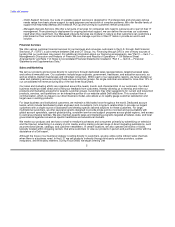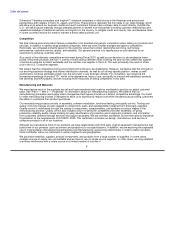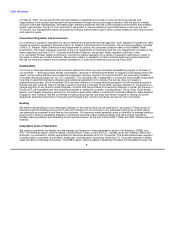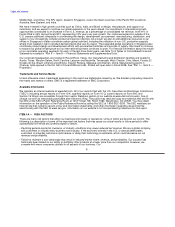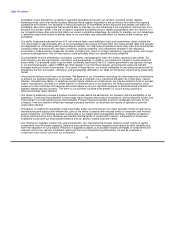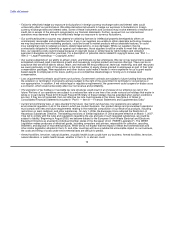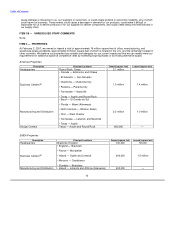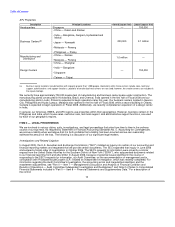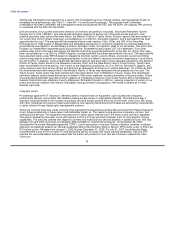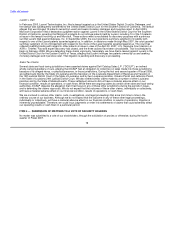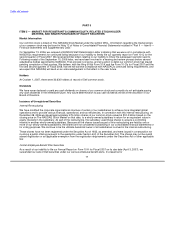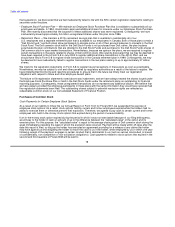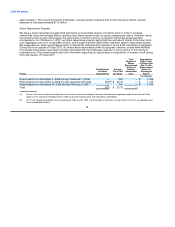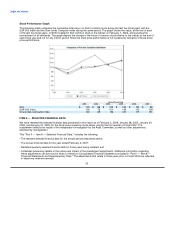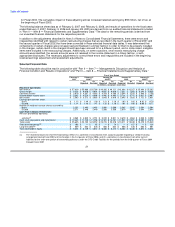Dell 2006 Annual Report Download - page 14
Download and view the complete annual report
Please find page 14 of the 2006 Dell annual report below. You can navigate through the pages in the report by either clicking on the pages listed below, or by using the keyword search tool below to find specific information within the annual report.
Table of Contents
• We could experience manufacturing interruptions, delays, or inefficiencies if we are unable to timely and reliably procure
components from single-source or limited-source suppliers. We maintain several single-source or limited-source supplier
relationships, either because multiple sources are not available or the relationship is advantageous due to performance,
quality, support, delivery, capacity, or price considerations. If the supply of a critical single- or limited-source material or
component is delayed or curtailed, we may not be able to ship the related product in desired quantities and in a timely
manner. Even where multiple sources of supply are available, qualification of the alternative suppliers and establishment of
reliable supplies could result in delays and a possible loss of sales, which could harm operating results.
• Our business is increasingly dependent on our ability to access the capital markets. We will increasingly rely upon access
to the capital markets to fund financing for our customers and to provide sources of liquidity in the U.S. for general
corporate purposes, including funding DFS growth. If we are unable to access the capital markets, we may not be able to
fully fund customer financing opportunities or planned share repurchases without repatriation of foreign cash balances. See
"Part II — Item 7 — Management's Discussion and Analysis of Financial Condition and Results of Operations — Liquidity,
Capital Commitments, and Contractual Cash Obligations — Liquidity." Although we believe that we will be able to maintain
sufficient access to the capital markets, adverse changes in the economy, deterioration in our business performance, or
changes in our credit ratings could limit our access to these markets.
• We face risks relating to our ineffective internal controls. As a result of our review of issues identified during the recently
completed independent Audit Committee investigation into certain accounting and financial reporting matters, as well as our
internal review, management has identified several deficiencies in our control environment that constitute material
weaknesses and, consequently, has concluded that our internal control over financial reporting was not effective at
February 2, 2007. In addition, management has concluded, based primarily on the identification of the material
weaknesses, that our disclosure controls and procedures were not effective at February 2, 2007. See "Part II — Item 9A —
Controls and Procedures." If we are unable to successfully remediate these material weaknesses in a timely manner,
investors may lose confidence in our reported financial information, which could lead to a decline in our stock price, limit our
ability to access the capital markets in the future, and require us to incur additional costs to improve our internal control
systems and procedures.
• Litigation and governmental investigations or proceedings arising out of or related to our recent accounting and financial
reporting investigation could result in substantial costs. We could incur substantial costs to defend and resolve litigation or
governmental investigations or proceedings arising out of or related to the recently completed Audit Committee
investigation into certain accounting and financial reporting matters. See "Part II — Item 7 — Management's Discussion and
Analysis of Financial Condition and Results of Operations — Audit Committee Independent Investigation and Restatement."
In addition, we could be exposed to enforcement or other actions with respect to these matters by the SEC's Division of
Enforcement or the U.S. Department of Justice. For a description of pending litigation and governmental proceedings and
investigations see "Part I — Item 3 — Legal Proceedings — Investigations and Related Litigation."
• The acquisition of other companies may present new risks. We recently began to pursue a targeted acquisition strategy
designed to augment areas of our business. These acquisitions may involve significant new risks and uncertainties,
including distraction of management attention away from our current business operations, insufficient new revenue to offset
expenses, inadequate return of capital, integration challenges, new regulatory requirements, and unidentified issues not
discovered in our due diligence process. No assurance can be given that such acquisitions will be successful and will not
adversely affect our profitability or operations.
• Failure to properly manage the distribution of our products and services may result in reduced revenue and profitability. We
use a variety of distribution methods to sell our products and services, including directly to customers and through retail
partners and third-party value-added resellers. Our inability to properly manage and balance these various distribution
methods could harm our operating results.
11






